Modeling Urban Temperature Using Measurements from Mobile and Stationary Monitoring Stations
Abstract
1. Introduction
2. Methods
2.1. Study Area
2.2. Topographic and Meteorological Data
2.3. Heat Balance Considerations
2.4. Mobile Data Implementation
3. Results
4. Discussion
5. Conclusions
Author Contributions
Funding
Institutional Review Board Statement
Informed Consent Statement
Data Availability Statement
Conflicts of Interest
References
- Tollefson, J. Ipcc climate report: Earth is warmer than it’s been in 125,000 years. Nature 2021, 596, 171–172. [Google Scholar] [CrossRef] [PubMed]
- Zhou, D.; Xiao, J.; Bonafoni, S.; Berger, C.; Deilami, K.; Zhou, Y.; Frolking, S.; Yao, R.; Qiao, Z.; Sobrino, J.A. Satellite remote sensing of surface urban heat islands: Progress, challenges, and perspectives. Remote Sens. 2018, 11, 48. [Google Scholar] [CrossRef]
- Zhou, J.; Chen, Y.; Wang, J.; Zhan, W. Maximum nighttime urban heat island (UHI) intensity simulation by integrating remotely sensed data and meteorological observations. IEEE J. Sel. Top. Appl. Earth Obs. Remote Sens. 2010, 1, 138–146. [Google Scholar] [CrossRef]
- Chen, X.-L.; Zhao, H.-M.; Li, P.-X.; Yin, Z.-Y. Remote sensing image-based analysis of the relationship between urban heat island and land use/cover changes. Remote Sens. Environ. 2006, 104, 133–146. [Google Scholar] [CrossRef]
- Chun, B.; Guldmann, J.-M. Spatial statistical analysis and simulation of the urban heat island in high-density central cities. Landsc. Urban Plan. 2014, 125, 76–88. [Google Scholar] [CrossRef]
- Mirzaei, P.A. Recent challenges in modeling of urban heat island. Sustain. Cities Soc. 2015, 19, 200–206. [Google Scholar] [CrossRef]
- Lin, J.; Qiu, S.; Tan, X.; Zhuang, Y. Measuring the relationship between morphological spatial pattern of green space and urban heat island using machine learning methods. Build. Environ. 2023, 228, 109910. [Google Scholar] [CrossRef]
- Hong, J.-W.; Hong, J.; Lee, S.-E.; Lee, J. Spatial distribution of urban heat island based on local climate zone of automatic weather station in Seoul metropolitan area. Atmosphere 2013, 23, 413–424. [Google Scholar] [CrossRef]
- Brandsma, T.; Wolters, D. Measurement and statistical modeling of the urban heat island of the city of Utrecht (the Netherlands). J. Appl. Meteorol. Climatol. 2012, 51, 1046–1060. [Google Scholar] [CrossRef]
- Gubler, M.; Christen, A.; Remund, J.; Brönnimann, S. Evaluation and application of a low-cost measurement network to study intra-urban temperature differences during summer 2018 in Bern, Switzerland. Urban Clim. 2021, 37, 100817. [Google Scholar] [CrossRef]
- Qi, Q.; Meng, Q.; Wang, J.; He, B.; Liang, H.; Ren, P. Applicability of mobile-measurement strategies to different periods: A field campaign in a precinct with a block park. Build. Environ. 2022, 211, 108762. [Google Scholar] [CrossRef]
- Liu, L.; Pan, X.; Jin, L.; Liu, L.; Liu, J. Association analysis on spatiotemporal characteristics of block-scale urban thermal environments based on a field mobile survey in Guangzhou, China. Urban Clim. 2022, 42, 101131. [Google Scholar] [CrossRef]
- Merbitz, H.; Fritz, S.; Schneider, C. Mobile measurements and regression modeling of the spatial particulate matter variability in an urban area. Sci. Total Environ. 2012, 438, 389–403. [Google Scholar] [CrossRef]
- Tsin, P.K.; Knudby, A.; Krayenhoff, E.S.; Ho, H.C.; Brauer, M.; Henderson, S.B. Microscale mobile monitoring of urban air temperature. Urban Clim. 2016, 18, 58–72. [Google Scholar] [CrossRef]
- Taha, H.; Levinson, R.; Mohegh, A.; Gilbert, H.; Ban-Weiss, G.; Chen, S. Air-temperature response to neighborhood-scale variations in albedo and canopy cover in the real world: Fine-resolution meteorological modeling and mobile temperature observations in the Los Angeles climate archipelago. Climate 2018, 6, 53. [Google Scholar] [CrossRef]
- Scire, J.S.; Robe, F.R.; Fernau, M.E.; Yamartino, R. A User’s Guide for the CALMET Meteorological Model. 2000. Available online: https://www.calpuff.org/calpuff/download/CALMET_UsersGuide.pdf (accessed on 4 October 2024).
- Grell, A.; Dudhia, J.; Stauffer, D. A Description of the Fifth-Generation Penn State/NCAR Mesoscale Model (MM5); University Corporation for Atmospheric Research: Boulder, CO, USA, 1994. [Google Scholar] [CrossRef]
- Skamarock, W.C.; Klemp, J.B.; Dudhia, J.; Gill, D.O.; Liu, Z.; Berner, J.; Wang, W.; Powers, J.G.; Duda, M.G.; Barker, D.M.; et al. A description of the advanced research WRF version 4. NCAR Tech. Note Ncar/Tn-556+ Str 2019, 145. [Google Scholar] [CrossRef]
- Rzeszutek, M. Parameterization and evaluation of the CALMET/CALPUFF model system in near-field and complex terrain-terrain data, grid resolution and terrain adjustment method. Sci. Total Environ. 2019, 689, 31–46. [Google Scholar] [CrossRef]
- Arregocés, H.A.; Rojano, R. Sensitivity of the CALMET-CALPUFF model system on estimating pm10 concentrations at a mining site in northern Colombia. Case Stud. Chem. Environ. Eng. 2023, 8, 100402. [Google Scholar] [CrossRef]
- United States Geological Survey. Available online: https://earthexplorer.usgs.gov/ (accessed on 10 September 2024).
- Korea Ministry of Environment Environmental Geographic Information Service. Available online: https://egis.me.go.kr/intro/land.do (accessed on 10 September 2024).
- Korea Meteorological Administration Open MET Data Portal. Available online: https://data.kma.go.kr/cmmn/main.do (accessed on 10 September 2024).
- Holtslag, A.; De Bruin, H. A Simple Scheme for Daytime Estimates of the Surface Fluxes from Routine Weather Data. J. Appl. Meteorol. Climatol. 1983, 22, 517–529. [Google Scholar] [CrossRef]
- Oke, T.R. The energetic basis of the urban heat island. Q. J. R. Meteorol. Soc. 1982, 108, 1–24. [Google Scholar] [CrossRef]
- Goodin, W.R.; McRae, G.J.; Seinfeld, J.H. An objective analysis technique for constructing three-dimensional urban-scale wind fields. J. Appl. Meteorol. Climatol. 1980, 19, 98–108. [Google Scholar] [CrossRef]
- Yocke, M.A.; Liu, M.K. Modeling Wind Distributions over Complex Terrain; Environmental Monitoring Systems Laboratory: Las Vegas, NV, USA; Office of Research and Development: Washington, DC, USA; US Environmental Protection Agency: Washington, DC, USA, 1979. [Google Scholar]
- Christopherson, R.W. Geosystems: An Introduction to Physical Geography; Simon & Schuster Books for Young Readers: New York, NY, USA, 1858. [Google Scholar]
- Rodríguez, L.R.; Ramos, J.S.; de la Flor, F.J.S.; Domínguez, S.Á. Analyzing the urban heat island: Comprehensive methodology for data gathering and optimal design of mobile transects. Sustain. Cities Soc. 2020, 55, 102027. [Google Scholar] [CrossRef]
- Kousis, I.; Pigliautile, I.; Pisello, A.L. Intra-urban microclimate investigation in urban heat island through a novel mobile monitoring system. Sci. Rep. 2021, 11, 9732. [Google Scholar] [CrossRef] [PubMed]
- Shi, R.; Hobbs, B.F.; Zaitchik, B.F.; Waugh, D.W.; Scott, A.A.; Zhang, Y. Monitoring intra-urban temperature with dense sensor networks: Fixed or mobile? An empirical study in Baltimore, MD. Urban Clim. 2021, 39, 100979. [Google Scholar] [CrossRef]
- Sun, C.-Y.; Kato, S.; Gou, Z. Application of low-cost sensors for urban heat island assessment: A case study in Taiwan. Sustainability 2019, 11, 2759. [Google Scholar] [CrossRef]
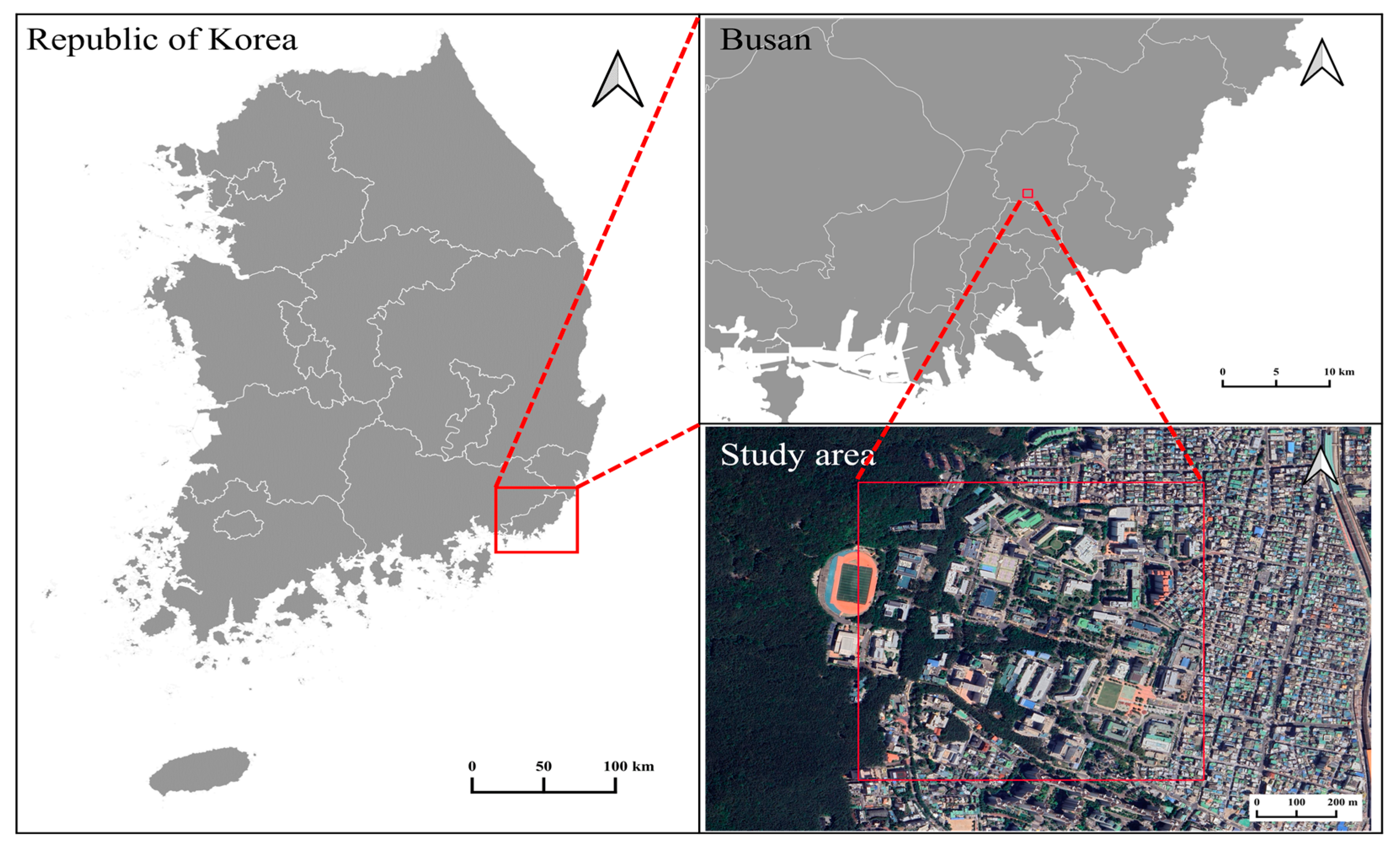
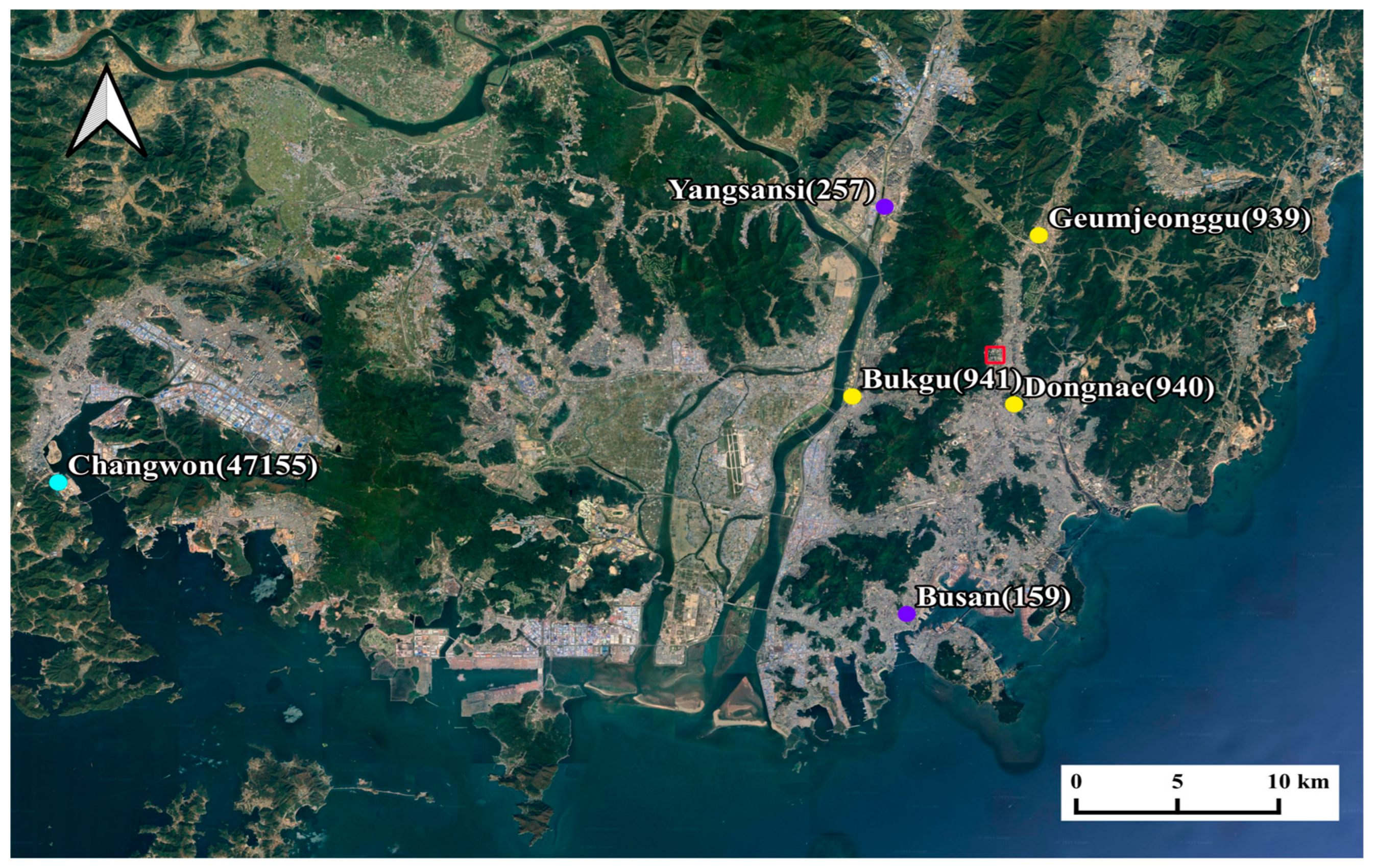

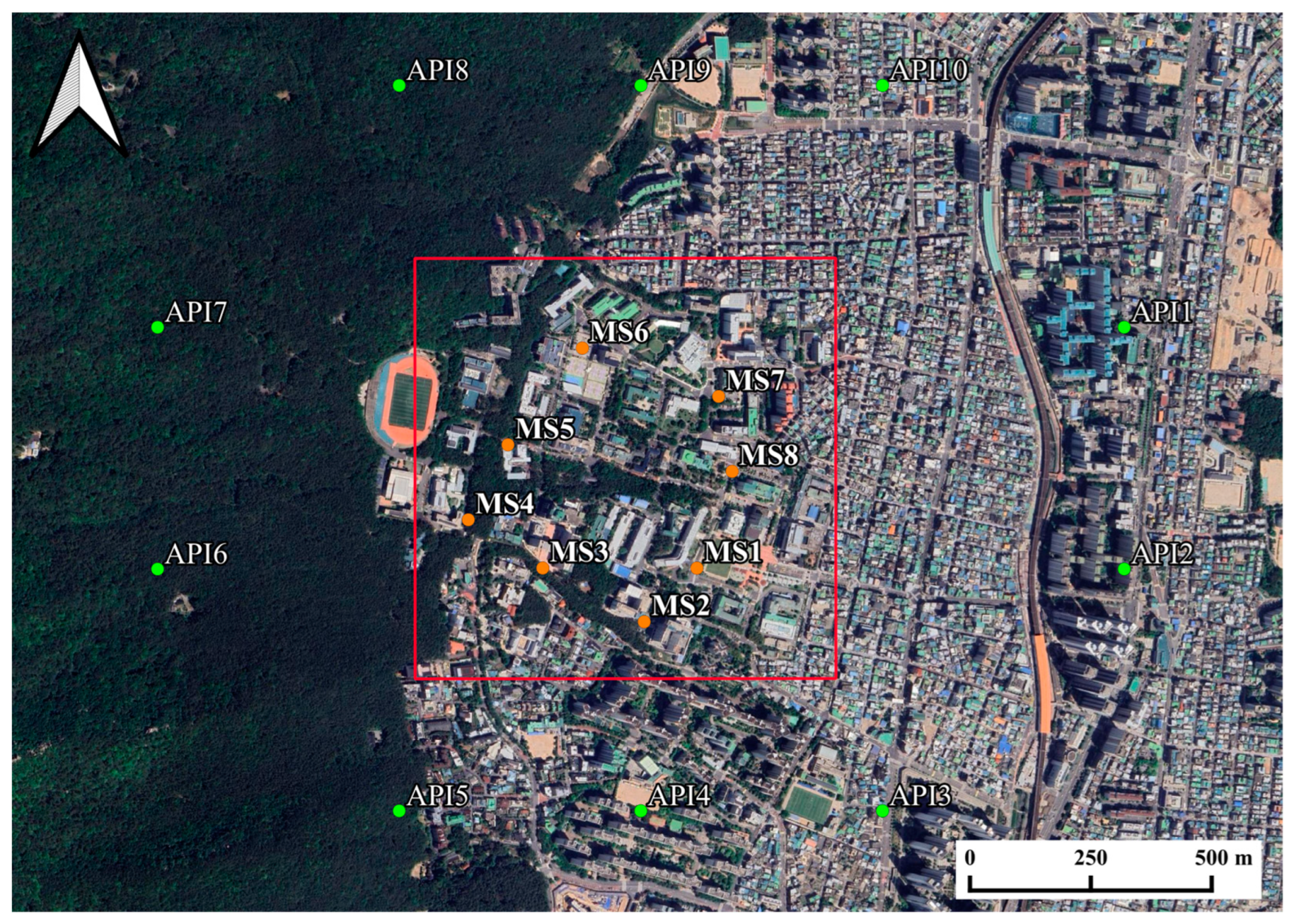
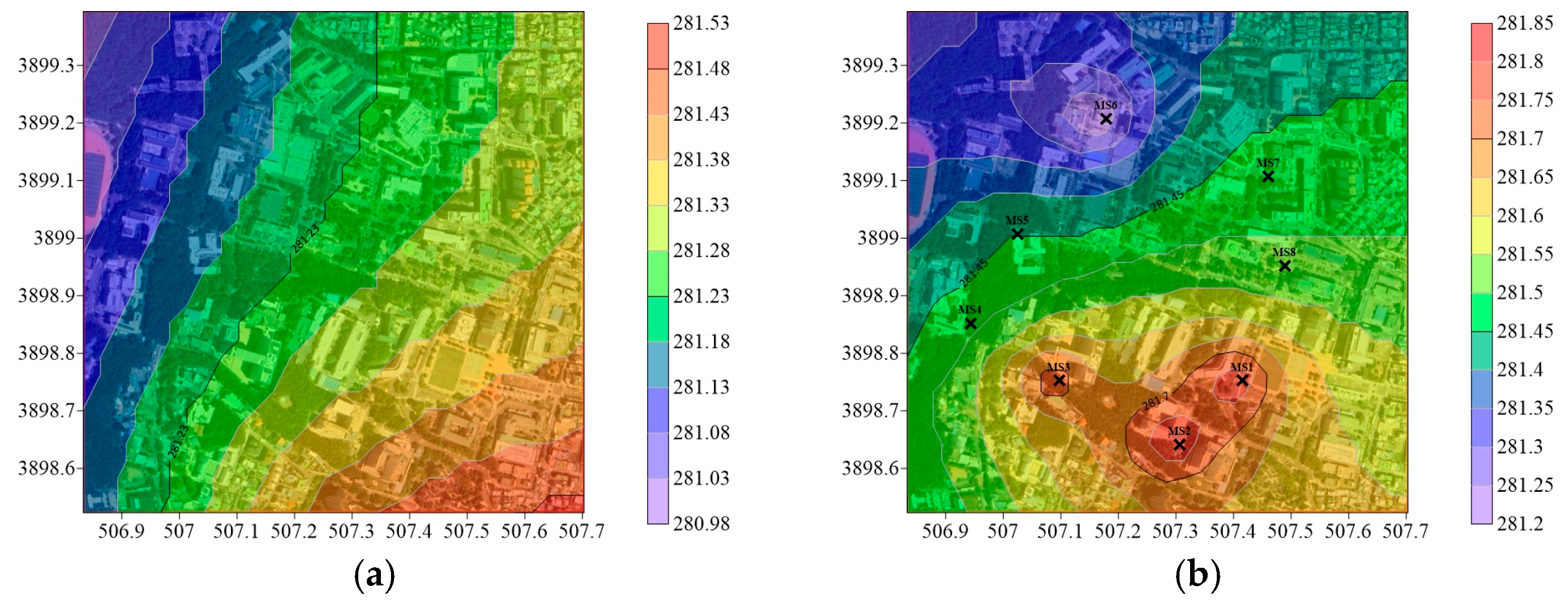
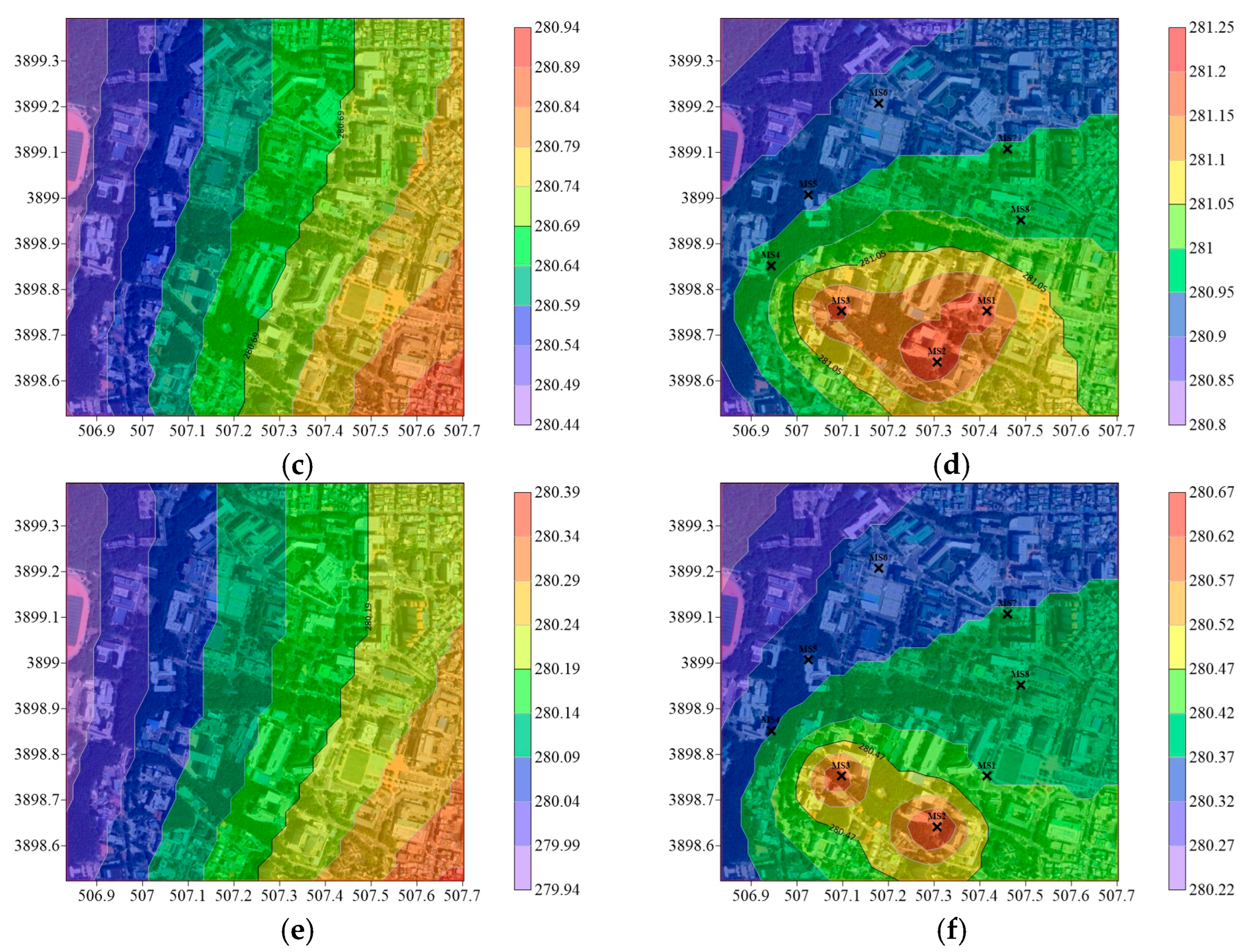
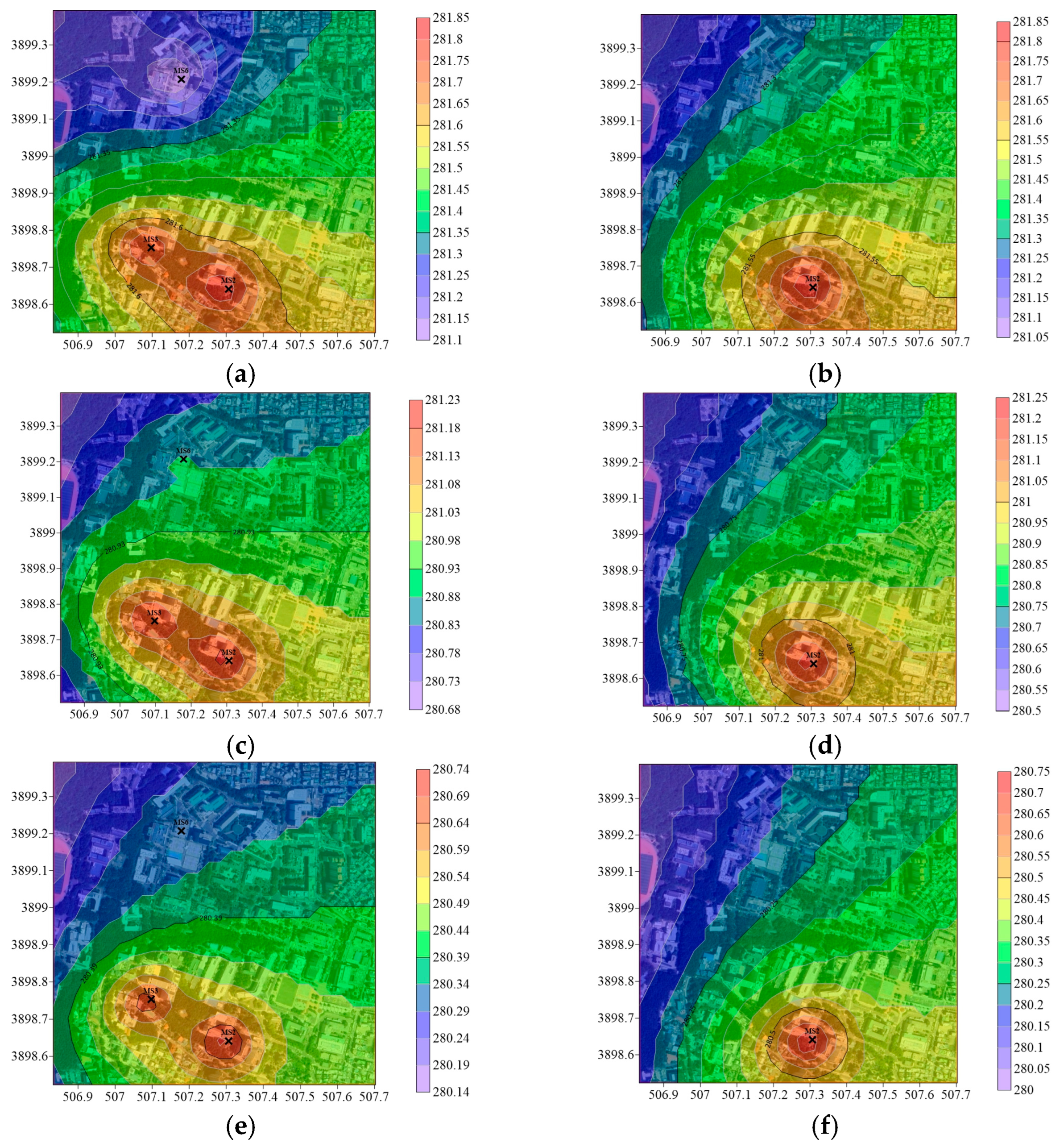
| Number of Mobile Point Implementations | Number of Mobile Data Combinations |
|---|---|
| 8 | 1 |
| 7 | 8 |
| 6 | 28 |
| 5 | 56 |
| 4 | 70 |
| 3 | 56 |
| 2 | 28 |
| 1 | 8 |
| 0 | 1 |
| Statistics in Differences | Timing | ||
|---|---|---|---|
| MRT-MS_0 | 15:00 | 16:00 | 17:00 |
| Average | 0.2415 | 0.328378 | 0.248089 |
| Max | 0.47 | 0.55 | 0.51 |
| Min | 0.04 | 0.16 | 0.08 |
| Std | 0.0806162 | 0.0882926 | 0.083973 |
| RMSE | 0.2548 | 0.340041 | 0.261915 |
| MRT-MS_3(236) | 15:00 | 16:00 | 17:00 |
| Average | 0.0685222 | 0.0478333 | −0.00851111 |
| Max | 0.21 | 0.16 | 0.07 |
| Min | −0.04 | −0.03 | −0.08 |
| Std | 0.0429384 | 0.0268012 | 0.0334565 |
| RMSE | 0.0808641 | 0.05483 | 0.0345221 |
| MRT-MS_4(5678) | 15:00 | 16:00 | 17:00 |
| Average | 0.191656 | 0.188389 | 0.127956 |
| Max | 0.41 | 0.41 | 0.38 |
| Min | 0.08 | 0.08 | 0.05 |
| Std | 0.077325 | 0.0828571 | 0.0707204 |
| RMSE | 0.206666 | 0.205805 | 0.146198 |
| MRT-MS_1(2) | 15:00 | 16:00 | 17:00 |
| Average | 0.0922333 | 0.163889 | 0.0993778 |
| Max | 0.23 | 0.28 | 0.29 |
| Min | −0.07 | 0.02 | −0.06 |
| Std | 0.0462651 | 0.0567332 | 0.0686541 |
| RMSE | 0.103186 | 0.173431 | 0.120786 |
Disclaimer/Publisher’s Note: The statements, opinions and data contained in all publications are solely those of the individual author(s) and contributor(s) and not of MDPI and/or the editor(s). MDPI and/or the editor(s) disclaim responsibility for any injury to people or property resulting from any ideas, methods, instructions or products referred to in the content. |
© 2024 by the authors. Licensee MDPI, Basel, Switzerland. This article is an open access article distributed under the terms and conditions of the Creative Commons Attribution (CC BY) license (https://creativecommons.org/licenses/by/4.0/).
Share and Cite
Lee, J.; Kim, S. Modeling Urban Temperature Using Measurements from Mobile and Stationary Monitoring Stations. Sustainability 2024, 16, 8897. https://doi.org/10.3390/su16208897
Lee J, Kim S. Modeling Urban Temperature Using Measurements from Mobile and Stationary Monitoring Stations. Sustainability. 2024; 16(20):8897. https://doi.org/10.3390/su16208897
Chicago/Turabian StyleLee, Jeongseop, and Sanghyun Kim. 2024. "Modeling Urban Temperature Using Measurements from Mobile and Stationary Monitoring Stations" Sustainability 16, no. 20: 8897. https://doi.org/10.3390/su16208897
APA StyleLee, J., & Kim, S. (2024). Modeling Urban Temperature Using Measurements from Mobile and Stationary Monitoring Stations. Sustainability, 16(20), 8897. https://doi.org/10.3390/su16208897







